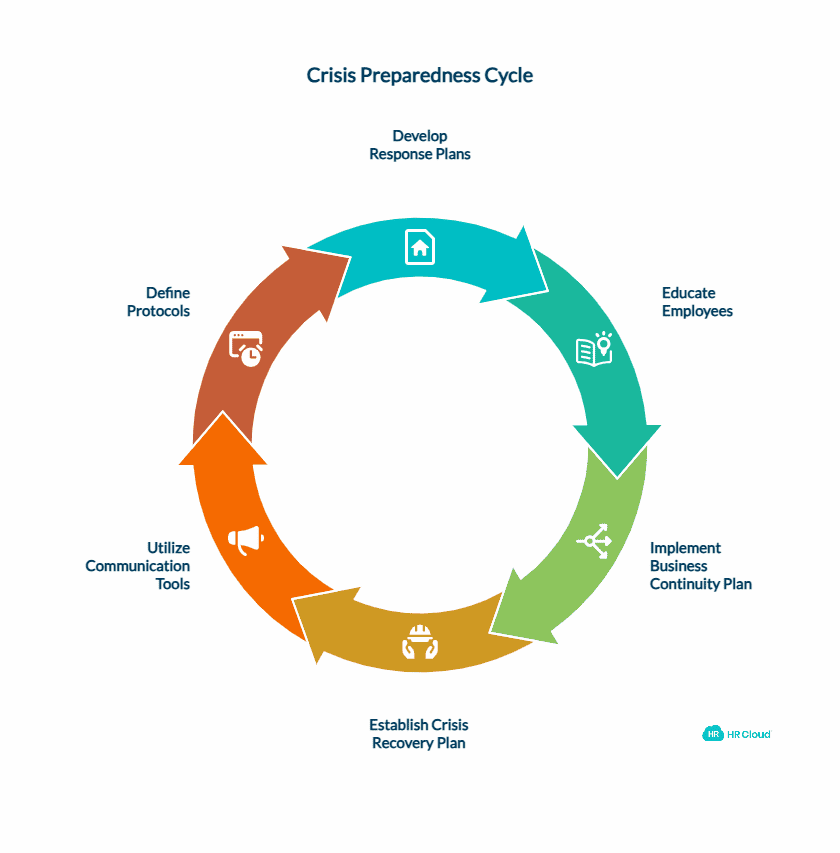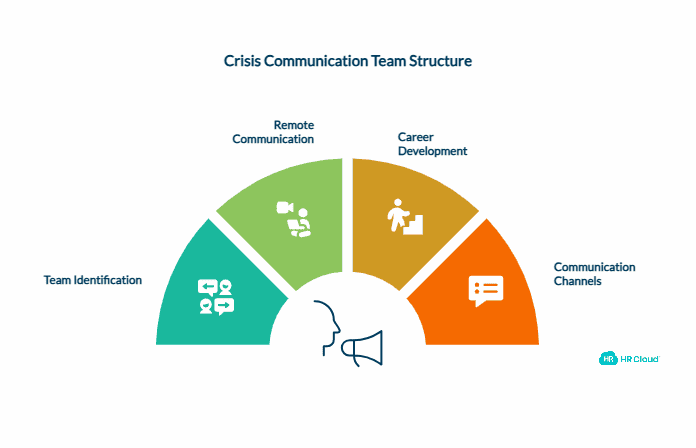Seven Crisis Communications Examples Every HR Professional Should Have



 Cut onboarding time
by 60%—here's the
Ultimate Checklist
that helped do it.
Cut onboarding time
by 60%—here's the
Ultimate Checklist
that helped do it.

In the ever-evolving landscape of HR trends, a crisis can affect your company at any time. In recent years, global events, technological disruption, and workforce shifts have transformed how we think about communication, connection, and work itself. Organizations today face a new reality—rapid change, hybrid workplaces, and rising employee expectations—making crisis management an essential HR function. This is especially crucial in light of increasing employee disengagement, skills shortages, and the ongoing need for organizational agility.
To react appropriately to a crisis, everyone in your organization has to be on the same page. Crises tend to arise unexpectedly, and communication during such times is of paramount importance. As challenging as these moments can be, they present a rare opportunity for you to strengthen your company’s reputation while maintaining employee engagement and workplace culture.
Today, many companies are adopting remote working models and hybrid setups as part of long-term workforce strategies. While these models bring flexibility, they also make consistent communication more complex. Digital tools have made it easier to stay connected, but how can you ensure everyone in your organization is getting the message while maintaining a healthy work-life balance?
It's a real challenge, yet here are seven crisis communication best practices you should implement in your company to maintain employee morale and organizational culture:
1. Prepare
The old saying is true: "Failing to prepare is preparing to fail." You may not be able to anticipate the exact nature of a crisis, but creating response plans and educating employees with regard to what a crisis looks like is essential. Your employees will appreciate having a crisis response template, which contributes to their professional development and psychological safety. This preparation can also help address issues like "soft quitting" and the "quiet quitting trend" that may arise during challenging times.
There are two plans that you should have in place above all else: Your business continuity plan and crisis recovery plan. The former ensures your organization will not be crippled during a crisis, and the latter will help dictate your response to the situation.
Adopt tools that allow you to quickly broadcast company-related announcements to your staff. Calling everyone on the floor to an all-hands meeting is impossible these days, and this is why you must define platform login and monitoring protocols. If your employees know what's expected of them before a crisis hits, they'll react in a coordinated manner once the situation becomes critical.
The old saying is true: “Failing to prepare is preparing to fail.” You can’t predict the exact nature of a crisis, but you can create structured response plans and train employees to recognize the signs early. Preparation gives employees clarity and confidence, strengthening both professional growth and psychological safety. It also helps prevent issues like disengagement or “quiet quitting” that often surface during stressful times.
There are two plans every organization should have ready: a business continuity plan and a crisis recovery plan. The first ensures your operations remain stable, while the second defines how you’ll respond when a disruption occurs.
Adopt tools that allow you to quickly broadcast company-wide announcements through secure, integrated platforms. In a hybrid work environment, you can’t always rely on in-person meetings—so it’s critical to define platform access, alert protocols, and communication workflows. When employees know what’s expected before a crisis hits, they respond in sync when it matters most.
2. Identify Crisis Communication Management Teams
Who are the key people responsible for managing a crisis? Identify and train them in advance so they can act with clarity when needed. With today’s distributed and hybrid workforces, strong communication between team members is essential. This process also provides professional development opportunities for those leading crisis management efforts.
Create dedicated communication channels for this team, and empower them to set up sub-channels for specific functions. Because every crisis unfolds differently, flexible and customizable communication software ensures teams can adapt quickly.
3. Notify
Crisis communication is all about ensuring there are no stones left unturned when it comes to delivering your message. This approach applies to your internal communication as well. Aside from broadcasting announcements on your software platform, make sure your employees receive notifications on their phones and email as well. These messages should be delivered via SMS/mobile apps and other functionality within a modern, social intranet or employee engagement platforms. It's important to consider the communication preferences of different generations, including Gen Z employees, who may prefer more digital and instant forms of communication.
Restrict sending such notifications solely for critical moments. You don't want your employees to tune out your messages by sending them irrelevant updates and announcements.


4. Encourage Responses With Employee Advocates
The old way of responding to a crisis was to batten down the hatches and restrict employees from talking about it. In the era of social media, not only is this the wrong approach to adopt, but it's also impossible to enforce. People turn to social media for information, and ignoring social conversations involving your company will damage your brand and employee wellbeing. It's crucial to address potential "loud quitting examples" that may occur on social media platforms during a crisis.
Encourage your employees to interact with customers and followers on your accounts and give them the opportunity to become brand advocates. Designate responsible employees or have someone from your crisis recovery team assume control of your accounts. Make sure your employees are up to speed concerning communication tone and response protocols.
5. Accuracy (Not Just Speed).png?width=816&height=573&name=Accuracy%20(Not%20Just%20Speed).png)
Your first instinct when a crisis hits will be to respond quickly to put out fires. However, an inaccurate or false response will only make the situation worse. Instead, focus on communicating honestly, and your employees will follow suit. Encourage your crisis management team to explore the situation and provide constant updates in your internal communications to all of your employees. This approach helps combat the negative effects of "hustle culture" that may push for quick but potentially inaccurate responses.
Above all else, never go silent. If your organization is gathering the facts surrounding the case, then communicate this internally and externally. Remaining silent conveys dishonesty and will damage your brand's reputation and employee trust.
6. Test
Regular crisis communication testing is the key to measuring the effectiveness of your response. Craft response templates in advance and share them through your HR platform to gather employee feedback and improve psychological safety.
Share these test responses in different communication channels to gain a well-rounded picture of what your employees think. Sharing it across the entire organization at once and opening the floor to feedback from everybody might result in you getting lost in the weeds.
Make sure you include relevant personnel contact information in these templates. Your employees can then use their HR mobile app to get in touch instantly with these people when the crisis hits.
7. Review
Once a crisis passes, review your workflow with your crisis management team. Gather feedback from employees through your HR platform's channels and incorporate this into your response moving forward. This process not only improves your crisis management but also contributes to employee development and engagement. Consider implementing employee recognition programs to acknowledge those who contributed positively during the crisis.
Find the Opportunity in a Crisis
A crisis will test your organization thoroughly, but it's also an opportunity for you to bounce back stronger than ever. Communicating decisively and clearly—with the right crisis communications plan—with your employees will help you respond as one to the crisis and will enhance your reputation. It will also bring your employees closer to one another, thanks to having dealt with the situation together, strengthening your workplace culture and supporting mental health.
With the workplace going remote these days, communication is of paramount importance. To learn many more tips, tricks, and best practices for communicating with remote teams, download our eBook, “A Better Way to Communicate, Engage, and Recognize & Reward Remote Workers.”
Keep Reading
45 Boss Day Messages That Actually Mean Something (2026 Guide)
When is Boss Day 2026? Mark your calendar for October 16, 2026 — the annual opportunity
Birthday Wishes for Coworkers: 50+ Messages That Build Workplace Connection
A coworker's birthday isn't just another calendar date—it's a meaningful opportunity to
Embracing Diversity: Recognizing Different Cultures in the Workplace
Workplaces today reflect the incredible diversity of the world around us. People bring
Like What You Hear?
We'd love to chat with you more about how HR Cloud® can support your business's HR needs. Book Your Free Demo

Build a Culture of Recognition. Boost Engagement. Guaranteed.
Workmates empowers employees to stay informed, connected, and appreciated—whether they’re on the front line, in the office, or remote. Recognition drives 12x higher engagement.Trusted by industry leaders in every sector




Cut Onboarding Costs by 60%.
Take the confusion and follow-ups out of onboarding with automated workflows, digital forms, and structured portals—so new hires ramp faster 3X quicker.Trusted by industry leaders in every sector




